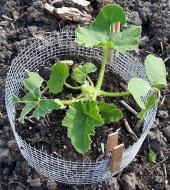













It's never too late to start! I retired to homestead on the slopes of Mauna Loa, an active volcano. I relate snippets of my endeavor on my blog : www.kaufarmer.blogspot.com









 1
1




 .
.My project thread: http://www.permies.com/t/20399/projects/Maine-Master-Plan
 1
1












Casie Becker wrote:It's amazing to me how few threads we have about germinating old seed. Is nearly everyone here a big enough gardener that they use up most of their seeds every year?
Casie Becker wrote:I used dense spacing and mixed seed varieties together and filled every bare corner of my garden with something. When it comes time to plant the warm season crops I'm actually going let them battle it out for the gardening space. Most of the cool season plants will be in decline from the heat by that point.
While I didn't manage to clear out the whole backlog of cooler season plants I've reduced it to things that we regularly grow that I know have a long shelf life. I still have a huge assortment of warm season plants that are going to go out later in the year. Since so many of these plants are large, I know I won't have garden space for all of them.
Casie Becker wrote: Weather here can be very variable from year to year, so having a wide variety available is essential to gardening success. Ideally I'd have seed from the survivors of every year. Finding out about land race gardening is probably going to turn out to the be best thing ever for my gardening, as before I was afraid to try saving seed from most vegetables. Now, once I've used up this backlog, I will at least only feel the need to store seeds by vegetable rather than having a lot of subtle different varieties.
Western Montana gardener and botanist in zone 6a according to 2012 zone update.
Gardening on lakebed sediments with 7 inch silty clay loam topsoil, 7 inch clay accumulation layer underneath, have added sand in places.

|
A teeny tiny vulgar attempt to get you to buy our stuff
Freaky Cheap Heat - 2 hour movie - HD streaming
https://permies.com/wiki/238453/Freaky-Cheap-Heat-hour-movie
|


